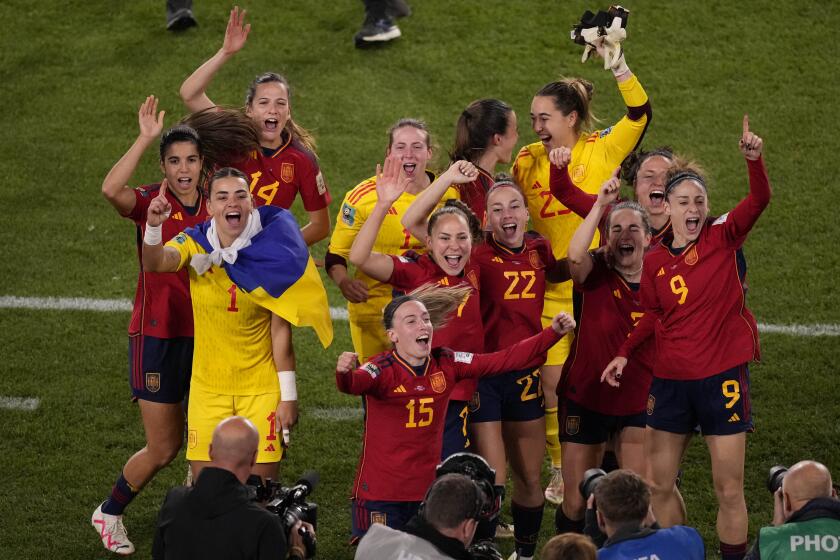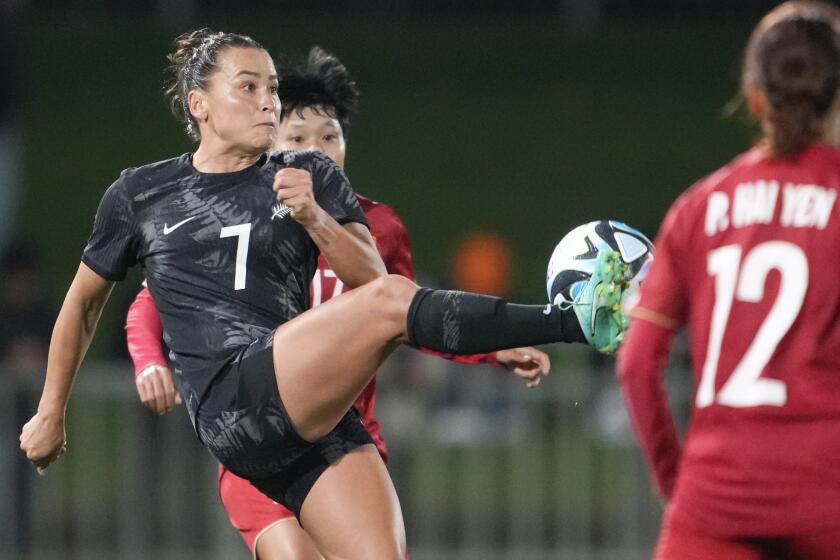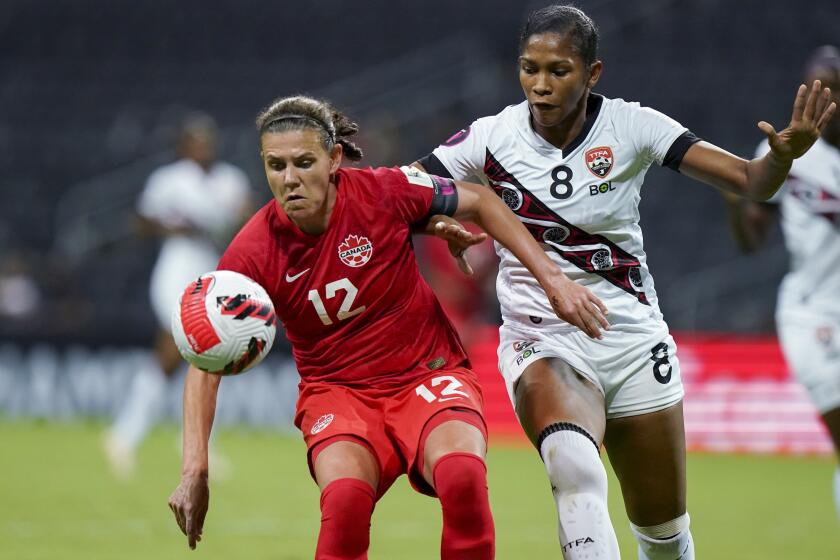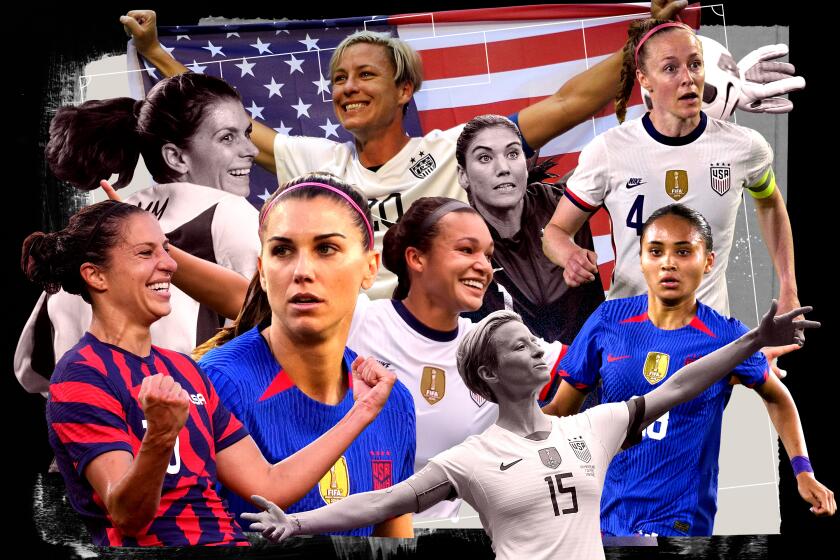World Cup is a win for Maori, showcasing Indigenous New Zealand culture long suppressed
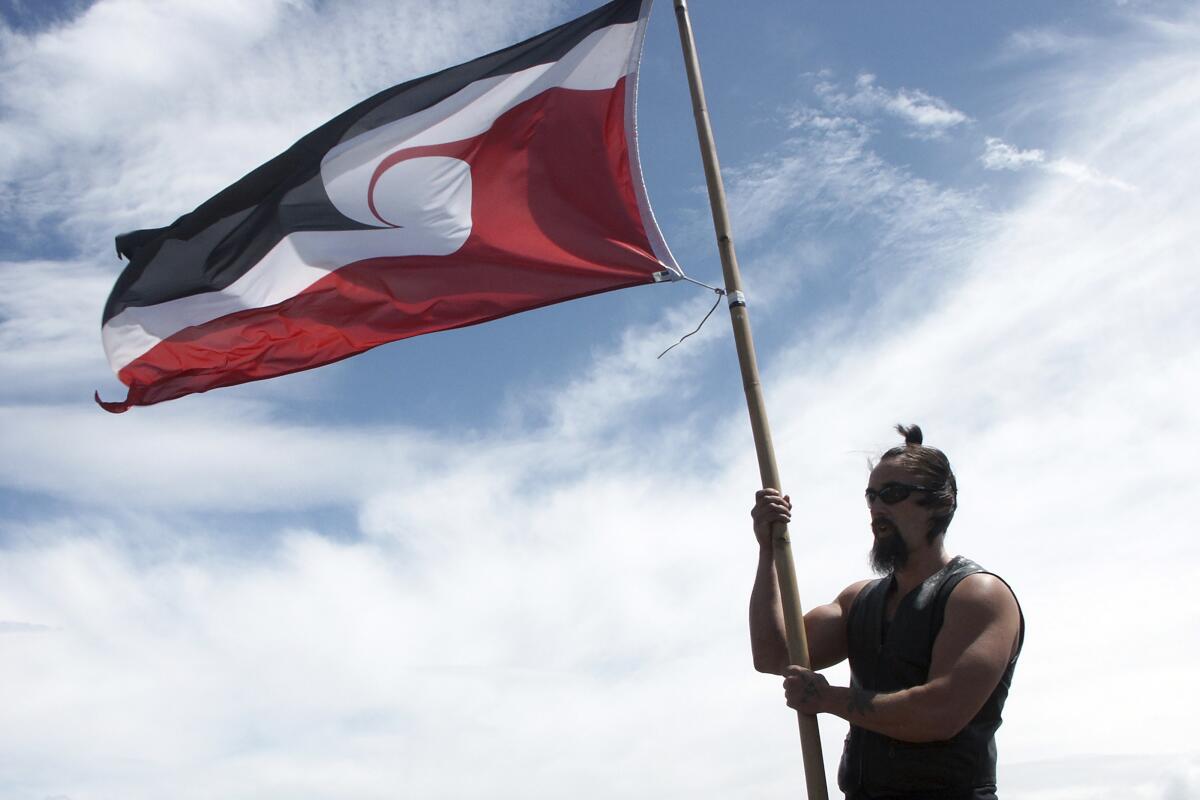
- Share via
AUCKLAND, New Zealand — Ceillhe Sperath’s ancestors arrived in New Zealand nearly two centuries before Christopher Columbus set off for the New World. Yet for much of the last two centuries, the Maori, the descendants of those early Polynesian explorers, have had to fight for the rights, recognition and respect they deserved.
So for Sperath, the most important moment of this summer’s Women’s World Cup, which kicks off early Thursday morning Pacific time, will come just before the first game when the Tino Rangatiratanga, the red and black Maori flag, is raised above Auckland’s Eden Park stadium and “God Defend New Zealand,” the country’s national anthem, is sung in te reo, the Maori language.
“It will be nothing short of inspirational,” said Sperath, who is a member of the Ngapuhi Northern tribe of New Zealand.
The Maori flag will fly over all four World Cup stadiums in New Zealand while the red, black and yellow Aboriginal flag will rise above six soccer venues in Australia. During a Women’s World Cup that will make history for being the largest with 32 teams, the first to be shared by two countries and the first played in the Southern Hemisphere, the fact it will open beneath the Maori flag is a more significant milestone for New Zealand’s Indigenous people.
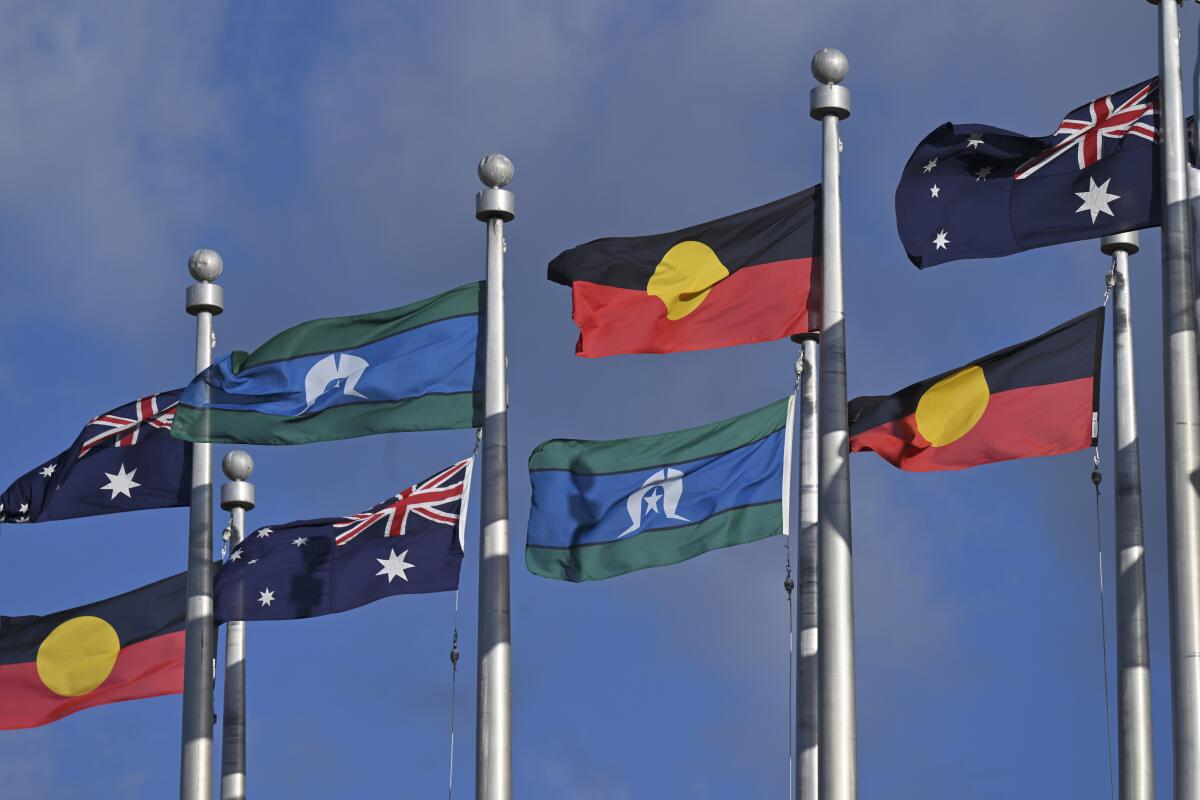
Andrew Pragnell, the chief executive of New Zealand’s soccer federation, said the gesture reflects “the partnership between the crown and Maori that is the foundation of this country.”
But that’s a foundation that has been newly laid, because for generations, Maori were subject to the same kind of prejudice, harassment and cultural genocide as Indigenous populations worldwide. In recent years, however, the Maori have made a comeback, marking one of the most ambitious efforts by a British colony to restore a language and a culture that the colonizers nearly wiped out.
“Events like these elevate our culture and remind us of how far we have come,” Sperath said, “and yet how far we need to go.”
In the 1990s, New Zealand began negotiating treaty settlements with Indigenous people to right historical wrongs, paying back more than half a billion dollars. Schools were established to teach the Maori language, and TV stations, websites and newspapers began carrying content in te reo. The results of those reforms have been impressive: Te reo is now an official language, and in the most recent census, taken in 2018, nearly 800,000 people, about 1 in 6 New Zealanders, identified as Maori — seven times the Maori population when Europeans first arrived at the end of the 18th century — with much of that growth coming through intermarriage.
“We are fortunate — as much as you can be if you’re a colonized culture, I suppose,” said Kiri Atkinson-Crean, a Maori who is head of tourism for Tauhara North Tourism, which operates cultural tourism experiences on New Zealand’s North Island.
“It’s just common sense. There’s barely 5 million of us and we live at the bottom of the world, quite frankly. It’s like, ‘Here we are, let’s make the most of it.’ It’s our collective history. That’s something for European New Zealanders and for Maori New Zealanders to celebrate. We’re all part of one single story. At some point, we connected, and we’re creating the next chapters.”
Complete coverage of the 2023 FIFA Women’s World Cup in Australia and New Zealand from the Los Angeles Times.
New Zealand, the last large habitable land mass on Earth to be populated, was for centuries home to nothing but birds and sea life when the Maori arrived from east Polynesia sometime around 1300, led by migratory birds and navigating by the stars and ocean currents. And because they lived mostly in isolation for more than four centuries, they developed a culture and language that was distinct, if familiar in origin, from other eastern Polynesian populations.
That was nearly wiped out in a matter of decades after Europeans came to New Zealand in the late 1700s. The colonists forced the Maori to assimilate to Western traditions and brought diseases such as influenza, smallpox and measles that killed as much as half the Indigenous population, which, at its height, had been estimated at more than 110,000.
The revitalization of the Maori and their culture began with the language. In 2016, the government passed the second Maori Language Act and two years later adopted a five-year strategy for revitalizing the language, in part by establishing a partnership between the crown and Te Matawai, an independent Maori advocacy group. The plan’s goals were to have at least a million New Zealanders speaking basic te reo, 85% of New Zealanders valuing the language as part of the country’s national identity, and 150,000 Maori under the age of 15 speaking the language as often as English by 2040.
That timeline seems overly cautious now because te reo has already gone mainstream, with emails from government officials commonly beginning with the greeting kia ora (hello) and ending in nga mihi nui (thank you very much). The language is proving so popular that teachers complain of being overwhelmed by classes that routinely draw hundreds of students, while heavy-metal and pop groups have shot to the top of New Zealand’s music charts with te reo songs. Two former prime ministers, Jacinda Ardern and Bill English, have made public addresses in the language.
Playing for host nation New Zealand in the 2023 Women’s World Cup will be a “culmination of so many milestones” for Angel City FC standout Ali Riley.
Even Disney has gotten on board with its 2016 animated film “Moana,” set on a fictional Polynesian island, featuring the voices of Maori actors Rachel House, Temuera Morrison and Jemaine Clement.
That’s a big difference from Atkinson-Crean’s school days, when children were punished for identifying as Maori, with some whipped for speaking te reo in class. Elsewhere, Maori were excluded from entering stores.
Now business leaders snap up Maori-speaking graduates because they have found including te reo phases in company documents helps brand them as being committed to New Zealand, while signage in government offices, hospitals and open public spaces is in both English and Maori.
One reason for the country’s progressive approach to Indigenous culture and language lies in the increasingly diverse nature of its population, especially in Auckland. More than 40% of the city’s 1.7 million residents were born elsewhere, with significant numbers of Chinese, Indians and South Pacific islanders immigrating in recent years. As a result, a walk along the hilly streets of New Zealand’s largest city commonly means exposure to a half-dozen languages.
“New Zealand wants to celebrate its uniqueness,” said Sperath, the founder and director of Auckland’s Time Unlimited Tours, one of a growing number of companies offering educational trips focused on New Zealand’s Indigenous history. “I’ve never met one person who came here by mistake. Like our ancestors, you have to intentionally want to make the journey and find out why New Zealand is so special. Our Indigenous culture is our unique selling point.”
Breaking down the top players, start times and schedules for each of the four-team groups in the 2023 Women’s World Cup.
There has been pushback, though, as when Simeon Brown, transportation spokesman for the opposition National Party, recently spoke out against a proposal to install bilingual road signs.
“There is always resistance to the Maori language. But the numbers are getting smaller,” said Tania M. Ka’ai, director of the Te Ipukarea Research Institute and Center for Language Revitalization in Auckland. “There is now a groundswell of New Zealanders who claim Maori language and culture as part of the national identity.”
And language is just part of the Maori identity.
“We always said the culture was the language. We didn’t know there was this missing piece,” Sperath said.
The true culture, she said, is family-oriented, built around consensus and a “go along to get along attitude” that mirrors the rest of the country.
“In New Zealand, you can be anything you want to be as long as you don’t force your way on everyone else,” she said. “People come here from other places because we’re more accepting.”
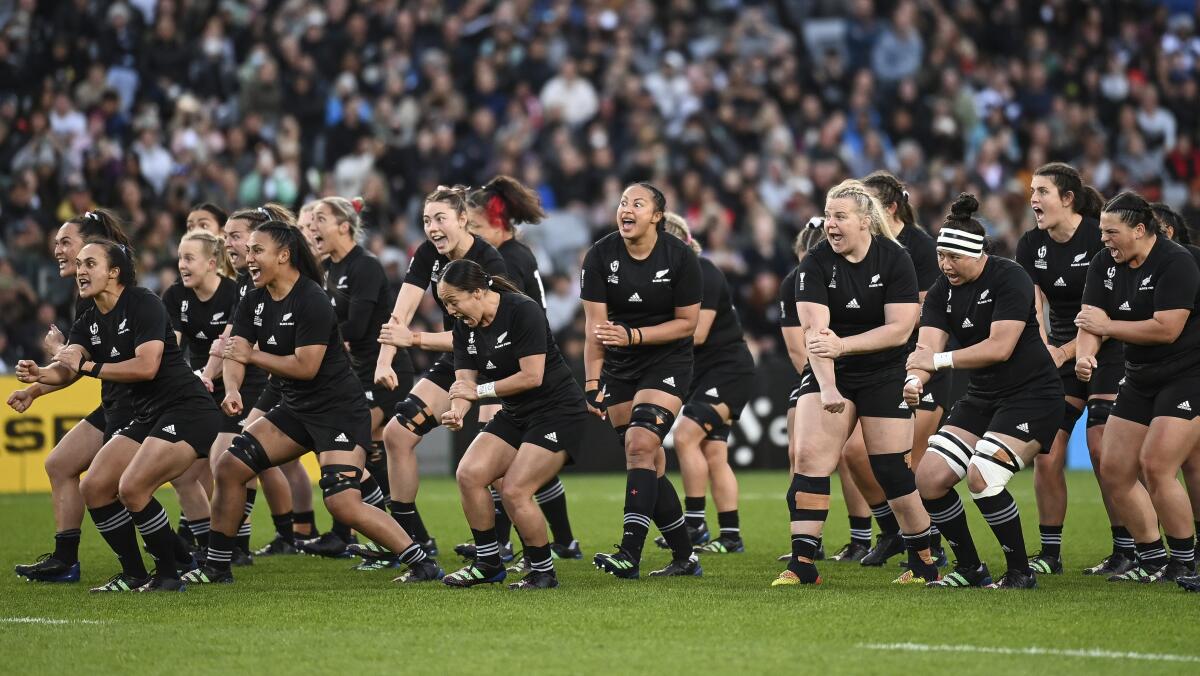
Not all Indigenous traditions have been treated with equal reverence. The haka, the ceremonial war dance or challenge, is perhaps the best-known Maori cultural touchstone outside New Zealand, due to its use by the All Blacks, the country’s three-time World Cup-champion rugby team. A complex combination of passion, vigor and aggression performed wild-eyed and featuring the stomping of feet and rhythmic body slapping, the haka dates to the 19th century and its spirit of defiance and protest, which inspired its creation, makes it well-suited for sports teams.
It has become a national emblem every bit as important to New Zealand’s image as the kiwi bird or the silver fern.
“I think generally there’s an acceptance among all Maori that if you are representing our country, then you have earned the right to perform the haka,” said Anton Matthews, who, with help his from sister Maia, has tried to popularize Maori traditions at their Christchurch restaurant Fush by printing their menu in te reo and giving language lessons.
Schools and other education groups are also given a pass from the Ngati Toa, the tribe that has legal guardianship of the haka, if they teach it with respect and sincerity, Matthews said. But others have crossed the line, with advertisers using the dance to sell cars and handbags. During the COVID-19 lockdown, anti-vaccination activists used it in their protests, drawing angry rebukes.
“That’s appropriation without a doubt,” Matthews said. “New Zealanders and Maori are becoming a little bit more aware of when there are businesses that are commercializing Maori culture, whether it be a design, whether it be something like the haka, or the language. They’ve sold it and they’re making money off it.”
Ahead of the 2023 Women’s World Cup in Australia and New Zealand, we review the USWNT’s all-time greats and its up-and-coming stars.
In response, the Maori have begun pushing back themselves to defend their culture and keep it from being trivialized.
“We’ve been fighters for a very, very long time to try to maintain what we could of our culture,” said Parereina Rawiri, part of a five-person troupe that teaches Maori customs, including the haka, at Auckland’s War Memorial Museum. “We’ve actually helped other Indigenous cultures around the world to elevate their level of maintaining their histories and their languages and things like that.”
Allies include FIFA, global soccer’s governing body and one that is traditionally conservative and hidebound. But it played against type by cheering the use of Indigenous flags and languages at this World Cup.
“FIFA recognizes the importance of Maori as tangata whenua in hosting the Women’s World Cup,” FIFA President Gianni Infantino said, using a te reo phrase that translates as “people of the land.”
For Sperath, the recognition is welcome, if overdue.
“We cannot change history, but we can learn from it to inform how we will be in the future,” she said. “If you want the rainbow, then you need to put up with the rain.”
More to Read
Sign up for Essential California
The most important California stories and recommendations in your inbox every morning.
You may occasionally receive promotional content from the Los Angeles Times.

